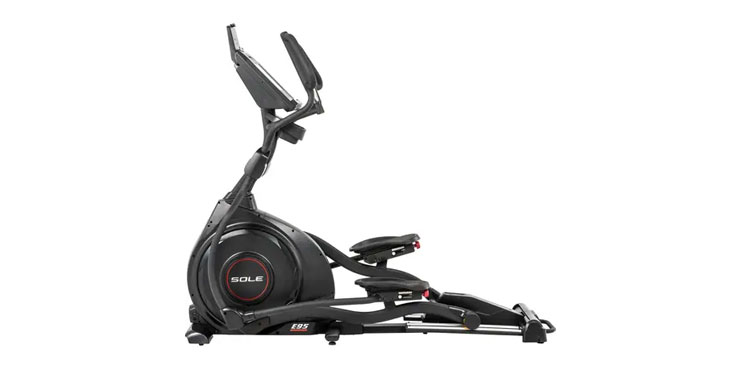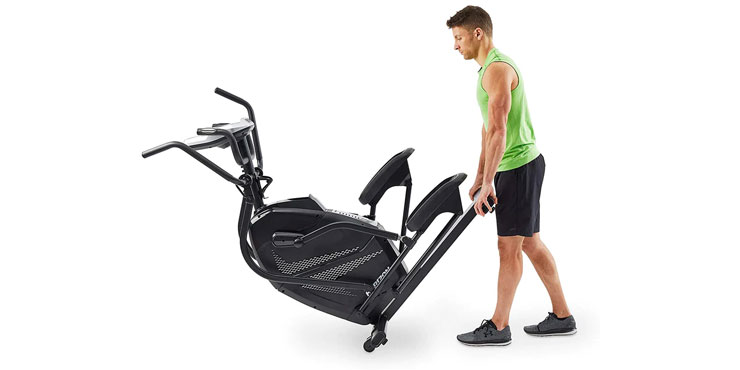30 Minutes on Elliptical Equals How Many Miles
We have not been running this blog for very long, but we are already getting questions from readers and it feels good. We realize that it can be quite difficult for a newcomer to understand all the questions that arise at once, so we will be happy to answer them. One of the questions we would like to write about is “30 minutes on elliptical equals how many miles?”.
Many people are confused about how to compare their training progress, how different types of devices calculate the distance traveled or the number of calories burned. If you have similar questions, this article is for you. So let’s get started.
Contents
- How Much Distance Equals a Mile on the Elliptical?
- What does the number of calories burned depend on?
- Intensity
- The Effect of Your Weight
- Inside vs Outside
- Is distance on elliptical same as treadmill?
- Does the elliptical count as steps?
- How Long on Elliptical for 10,000 Steps?
- Duration of Training
- Bottom Line
How Much Distance Equals a Mile on the Elliptical?
The number of miles you can cover in 30 minutes on an elliptical machine can vary depending on several factors, including your speed, resistance level, and the specific elliptical machine you’re using.
On average, a moderate-intensity workout on an elliptical machine can burn about 150-300 calories in 30 minutes. If you want to convert this calorie burn into miles, you can use a rough estimate based on the average calories burned per mile for different types of exercise.
If your weight is 200 lbs and you plan to workout at a moderate intensity, you will burn approximately 233 calories in 30 minutes. According to the opinion of Dr. Daniel W. Vigil, associate professor of health sciences at the David Geffen School of Medicine at UCLA, the estimate of calories burned per mile is approximately 100 calories per mile.
Running or jogging at a pace of about 6 miles per hour burns about 100 calories per mile for an average-sized person. If you burn 150-300 calories in 30 minutes on an elliptical machine, that’s about equate to 1.5 to 3 miles.
What does the number of calories burned depend on?
Keep in mind that these numbers are estimates and can vary based on individual factors such as weight, age, gender, and intensity level. The values provided are based on averages and should be used as general guidelines.
Here’s a breakdown of the approximate calories burned on an elliptical machine for a 30-minute workout at various intensity levels:
| Intensity Level | Calories Burned in 30 Minutes |
|---|---|
| Low Intensity | 150 – 200 calories |
| Moderate Intensity | 200 – 250 calories |
| High Intensity | 250 – 300+ calories |
Intensity
Please note that these ranges are approximate and can vary based on factors like your weight and effort level. To get a more accurate estimate, you can use heart rate monitors or fitness trackers that provide real-time data on your calorie burn during the workout.
Here’s a bit more detail on each intensity level:
- Low Intensity: This is a comfortable pace where you’re moving smoothly without much effort. Your heart rate and breathing rate will increase slightly, but you should still be able to carry on a conversation easily.
- Moderate Intensity: You’re working harder, and your heart rate is noticeably elevated. You’re likely breathing faster and starting to break a sweat. It’s a challenging but sustainable pace, and you can maintain it for the full 30 minutes.
- High Intensity: This level involves pushing yourself to the limit. Your heart rate is significantly elevated, and you’re breathing heavily. You’re working at or near your maximum effort and might only be able to sustain this intensity for shorter bursts within the 30-minute session.
The Effect of Your Weight
Weight plays a significant role in determining the amount of calories burned during exercise, including elliptical exercise. The relationship between weight and calories burned is based on the principle that a heavier body requires more energy to move and therefore burns more calories. Here’s how weight affects the amount of calories burned on the elliptical:
- Caloric Expenditure: When you perform any form of physical activity, your body expends energy in the form of calories. The amount of energy expended depends on the effort required to move your body. Heavier individuals require more effort to move their bodies, which leads to a higher caloric expenditure compared to lighter individuals doing the same activity at the same intensity and duration.
- Metabolic Rate: Your basal metabolic rate (BMR) is the amount of energy your body requires to maintain basic functions at rest. Generally, individuals with higher body weights have higher BMRs because their larger bodies require more energy to function. When engaging in exercise like using an elliptical machine, this higher baseline metabolic rate contributes to a greater calorie burn.
- Energy Expenditure Formula: The relationship between weight and calorie burn is often estimated using a formula that takes into account weight, time, and activity intensity. One commonly used formula is the MET (Metabolic Equivalent of Task) formula. MET values represent the energy expenditure of various activities relative to your resting metabolic rate.
The formula is: Calories Burned = MET value × weight in kg × duration in hours
Inside vs Outside
If you want to compare 30 minutes on elliptical equals how many miles outdoors, then it is important to consider a number of additional factors. Exercising on an elliptical is a slightly higher intensity workout than running. But even if you compare a treadmill workout to an outdoor jog, you will burn a different number of calories.
The amount of calories burned can vary between indoor and outdoor workouts due to several factors. Here are some factors that contribute to the difference in calories burned between indoor and outdoor exercise:
- Environmental factors: When exercising outdoors, you may encounter different terrain, wind resistance, and elevation changes. These factors can lead to increased exertion and energy expenditure compared to exercising on a stationary indoor machine with consistent conditions.
- Wind Resistance: When you’re outdoors, you often have to overcome wind resistance, especially when you’re running or cycling. Wind resistance can make your workout more challenging and increase the number of calories burned compared to a controlled indoor environment.
- Temperature: Outdoor temperature can affect calorie expenditure. Exercising in colder temperatures may result in a slightly higher calorie burn as your body works to maintain its core temperature. Similarly, hot and humid conditions can increase energy expenditure as your body works to cool itself.
- Terrain and altitude: When you’re outdoors, you may encounter hills, slopes, and uneven surfaces that require more effort to traverse. Uphill sections can increase the intensity of your workout and consequently the number of calories burned.
- Surface Effect: Running or walking on different surfaces, such as pavement, grass, or trails, can affect the impact on your joints and muscles. Softer surfaces may require slightly more energy, while harder surfaces may be more efficient.
- Mental stimulation: Outdoor environments can provide mental stimulation and distractions that can affect your perception of effort. This can lead to variations in how hard you feel you’re working and, consequently, how many calories you burn.
- Indoor Equipment: The type of indoor exercise equipment you use can affect the amount of calories you burn. For example, using a treadmill with incline settings can simulate outdoor conditions and increase energy expenditure.
- Cooling and air conditioning: Indoor workouts often take place in climate-controlled environments, which may result in less temperature-related calorie expenditure than outdoor workouts in varying weather conditions.
While these factors can contribute to differences in calories burned, it’s important to note that the differences are not always significant. The most important factor in achieving your fitness goals is consistency.
Whether you exercise indoors or outdoors, the key is to find an activity that you enjoy and can stick with over time. The small differences in calories burned between indoor and outdoor workouts shouldn’t be the primary focus; instead, choose activities that match your goals and preferences.
Is distance on elliptical same as treadmill?
The distance you travel on an elliptical machine and a treadmill can be different, even though you’re exerting the same amount of force. This is because the two machines simulate different types of movement.
On a treadmill, you’re essentially walking or running in a linear fashion, and the distance you travel is equivalent to the actual distance you would travel if you walked or ran outside.
On the other hand, an elliptical machine provides a circular or elliptical motion that is more like a combination of walking, cycling and stair climbing. Because of this circular motion, the distance displayed on the elliptical machine may not directly correspond to the actual linear distance you would travel if you were moving in a straight line on the ground.
When using an elliptical machine, the distance displayed is usually an estimate based on the number of revolutions your legs make on the elliptical pedals. This may differ from the actual distance you would travel if you were walking or running on a straight path.
If you’re comparing distances to track your workouts, it’s generally a good idea to stick to one type of machine so that your measurements are consistent. In addition, many elliptical machines allow you to enter your weight, which can help provide a more accurate estimate of calories burned and distance traveled based on your personal information and the machine’s algorithms.
Does the elliptical count as steps?
Yes, many modern elliptical machines are equipped with sensors that track your strides or pedal rotations, and they often convert these movements into an estimate of the number of steps you would have taken if you were walking or running. This step count is then used to calculate metrics such as distance traveled and calories burned.
It’s important to note, however, that the step count on an elliptical machine may not be as accurate as a step count taken while walking or running on a flat surface. This is because the motion on an elliptical machine is different from the natural gait of walking, and the machine’s sensors may not perfectly replicate the mechanics of walking or running.
If you’re using an elliptical machine to track your steps for fitness or health purposes, it’s a good idea to use the elliptical’s step count as a relative measure of your activity level rather than an absolute measurement. If accuracy in counting steps is important to you, using a pedometer or fitness tracker designed specifically for counting steps may be a better option.
Part of the accuracy of the measurements depends on the level of automation used. In more expensive models such as the Sole E95 the calculation will be more accurate.
How Long on Elliptical for 10,000 Steps?
The time it takes to reach 10,000 steps on an elliptical can vary depending on factors such as stride length, resistance level, and individual speed. However, I can give you a general estimate.
A commonly used standard for stride length is about 2.5 feet (30 inches or 76 cm). So, to calculate the distance traveled for 10,000 steps
Distance = stride length × number of steps
Distance = 30 inches × 10,000 steps
Distance = 300,000 inches
Now let’s convert this distance to a more common unit, such as miles:
Distance in miles = Distance in inches / 63,360 (number of inches in a mile)
Distance in miles = 300,000 / 63,360
Distance in miles ≈ 4.73 miles
Note that this is only a rough estimate. The time it takes to complete this distance on an elliptical machine depends on your pace, resistance level, and other variables. On average, a person can burn about 100 calories per mile on an elliptical machine, but this can vary.
Assuming an average pace and calorie burn, it may take about 45-60 minutes of continuous elliptical use to reach 10,000 steps. However, this is a general estimate and individual results can vary widely. It’s important to listen to your body and adjust the duration and intensity of your workout based on your fitness level and comfort.
Duration of Training
Is a 30 minute workout enough? This is also a pretty common question we get. The optimal duration of an elliptical workout can vary depending on your fitness goals, fitness level, and overall exercise routine. Here are some guidelines to help you determine an optimal workout duration:
1. Fitness Goals: Your goals play a significant role in determining the duration of your elliptical workout. Here are a few examples:
- Weight Loss: Longer workouts can be beneficial for weight loss, as they allow for a higher total calorie burn. Aim for sessions of 30-60 minutes or more.
- Cardiovascular Fitness: For improving cardiovascular health, moderate to high-intensity workouts of 20-45 minutes can be effective.
- Endurance Building: If you’re aiming to build endurance, longer workouts of 45-90 minutes can be beneficial, especially if you’re training for a specific endurance event.
2. Intensity: The intensity of your workout influences the ideal duration. Higher-intensity workouts can be effective in shorter durations, while lower-intensity sessions may require longer durations.
3. Fitness Level: Your current fitness level affects how long you can sustain a particular intensity. Beginners might start with shorter sessions and gradually increase the duration as their fitness improves. More advanced individuals might be able to handle longer and more intense workouts.
4. Time Availability: Consider how much time you have available for exercise. If you’re limited on time, you can still benefit from shorter, more intense workouts. On days when you have more time, you might opt for longer sessions.
5. Recovery: Adequate recovery time is important to prevent overtraining and reduce the risk of injury. Make sure to have rest days or lighter workout days between longer or more intense sessions.
Ultimately, the optimal workout duration is one that aligns with your goals, fits your schedule, and allows you to maintain a consistent exercise routine. It’s important to listen to your body and avoid overexertion. If you’re new to exercise or have any health concerns, consider consulting with a healthcare professional or a fitness expert to create a workout plan that’s tailored to your individual needs and goals.
Bottom Line
We hope that our answer has been clear and that we have helped you to understand this topic and its related issues. If you would like to clarify even the simplest misunderstandings, please send your questions to the email address listed in the Contacts section. We will try to give you a detailed answer.










